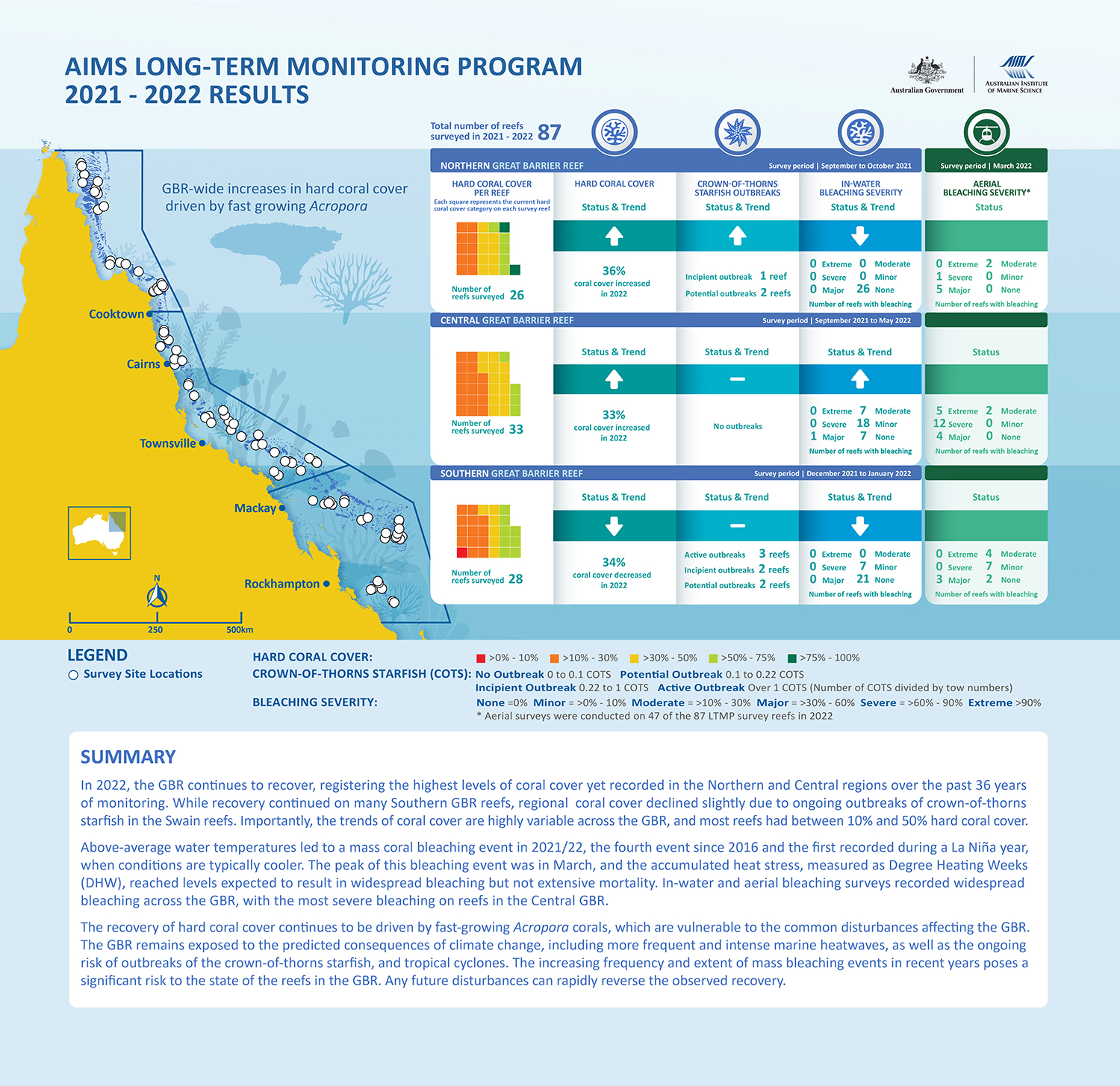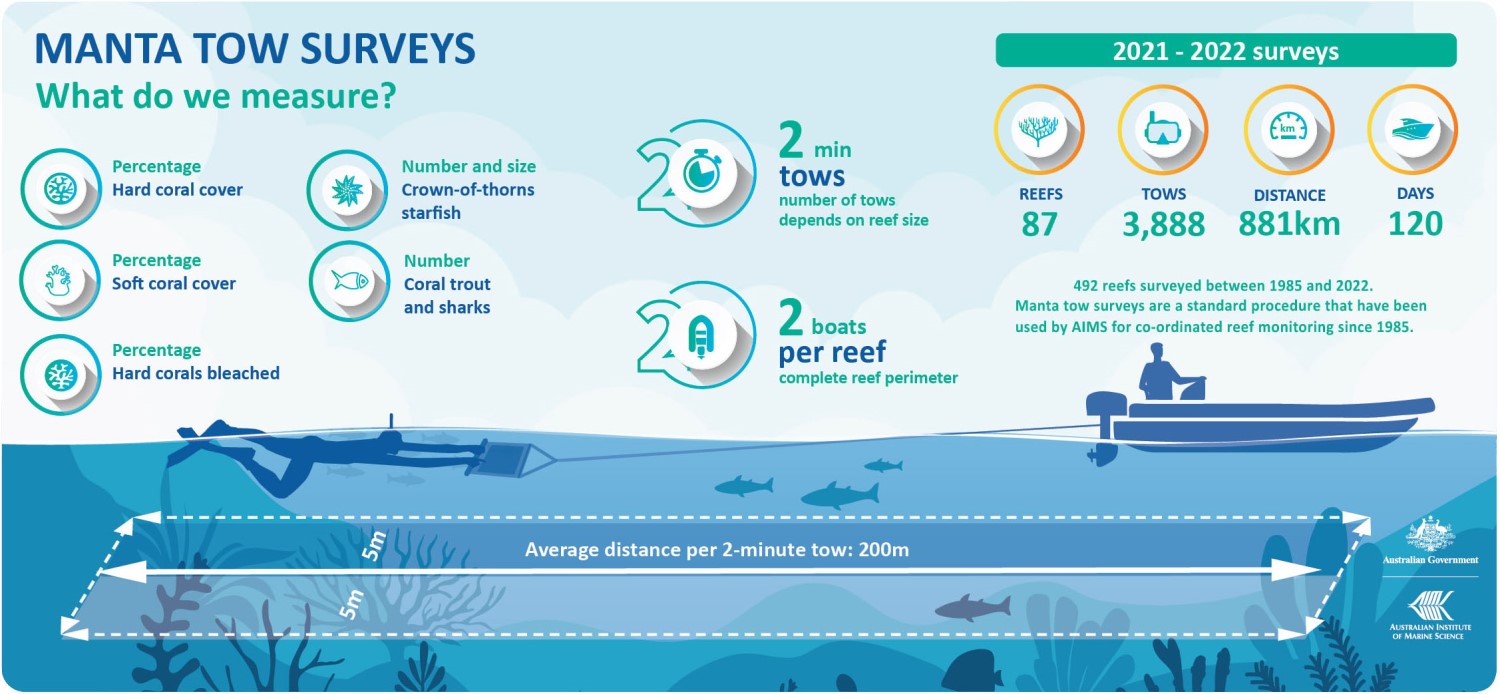Annual Summary Report of Coral Reef Condition 2021/22
Long-Term Monitoring Program
Annual Summary Report of Coral Reef Condition 2021/22

Download this Report | 4MB – Published 4th August 2022
Key Results
- This report summarises the condition of coral reefs of the Great Barrier Reef (GBR) from the Long-Term Monitoring Program (LTMP) surveys of 87 reefs conducted between August 2021 and May 2022 (reported as ‘2022’).
- Over the past 36 years of monitoring by the Australian Institute of Marine Science (AIMS), coral reefs in the GBR have shown an ability to begin recovery after disturbances.
- In 2022, widespread recovery has led to the highest coral cover recorded by the LTMP in the Northern and Central GBR, largely due to increases in the fast-growing Acropora corals, which are the dominant group of corals on the GBR and have been largely responsible previous changes in hard coral cover.
- Above-average water temperatures led to a mass coral bleaching event over the austral summer of 2021/22, the fourth event since 2016 and the first recorded during a La Niña year. The peak of this bleaching event was in March, and accumulated heat stress measured as Degree Heating Weeks (DHW)1 for most of the GBR reached levels expected to result in widespread bleaching but not extensive mortality.
- Survey reefs experienced low levels of other acute stress over the past 12 months, with no severe cyclones impacting the Marine Park. The number of crown-of-thorns starfish outbreaks on survey reefs has generally decreased; however, there remain ongoing outbreaks on some reefs in the Southern GBR.
- The combination of few acute stresses and lower accumulated heat stress in 2020 and 2022 compared to 2016 and 2017 has resulted in low coral mortality and has allowed coral cover to continue to increase in the Northern and Central GBR.
- Nearly half of the surveyed reefs (39 out of 87) had hard coral cover levels between 10% and 30%, while almost a third of the surveyed reefs (28 out of 87) had hard coral cover levels between 30% and 50%.
- On the Central and Northern GBR, region-wide hard coral cover reached 33% and 36%, respectively; the highest level recorded in the past 36 years of monitoring.
- Region-wide hard coral cover on reefs in the Southern GBR was 34% and had decreased from 38% in 2021, largely due to ongoing crown-of-thorns starfish outbreaks.
- In periods free from intense acute disturbances, most GBR coral reefs demonstrate resilience through the ability to begin recovery. However, the reefs of the GBR continue to be exposed to cumulative stressors. The prognosis for the future disturbance regime suggests increasing and longer-lasting marine heatwaves, as well as the ongoing risk of outbreaks of crown-of-thorns starfish and tropical cyclones. Therefore, while the observed recovery offers good news for the overall state of the GBR, there is increasing concern for its ability to maintain this state.
1 DHW expresses the accumulated heat stress over the previous three months by adding up the time when temperature exceeds the bleaching threshold. Significant coral bleaching is predicted above 4 DHW and coral mortality is expected above 8 DHW. Further information available from NOAA.

Source – https://www.aims.gov.au/monitoring-great-barrier-reef/gbr-condition-summary-2021-22
